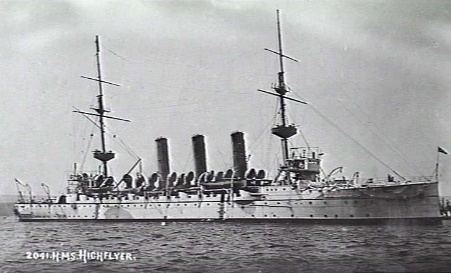Name Highflyer Preceded by Pelorus class Built 1897–1900 | Succeeded by Challenger class In service 1899–1921 | |
 | ||
The Highflyer-class cruisers were a group of three second-class protected cruisers built for the Royal Navy in the late 1890s.
Contents
Design and description
The Highflyer-class cruisers were essentially repeats of the previous Eclipse class, albeit with a more powerful armament and propulsion machinery. They were designed to displace 5,650 long tons (5,740 t). The ships had an overall length of 372 feet (113.4 m), a beam of 54 feet (16.5 m) and a draught of 21 feet 6 inches (6.6 m). Their crew consisted of 470 officers and other ranks.
The ships were powered by two 4-cylinder triple-expansion steam engines, each driving one shaft, using steam provided by 18 Belleville boilers, which were lighter and more powerful than the cylindrical boilers used by the Eclipses. The engines were designed to produce a total of 10,000 indicated horsepower (7,500 kW) which was intended to give a maximum speed of 20 knots (37 km/h; 23 mph). The ships easily exceeded their designed power and speeds during their sea trials. They carried a maximum of 1,125 long tons (1,143 t) of coal.
The main armament of the Highflyer class consisted of 11 quick-firing (QF) 6-inch (152 mm) Mk I guns. One gun was mounted on the forecastle and two others were positioned on the quarterdeck. The remaining eight guns were placed port and starboard amidships. They had a maximum range of approximately 10,000 yards (9,100 m) with their 100-pound (45 kg) shells. Eight QF 12-pounder 12 cwt guns were fitted for defence against torpedo boats. One additional 12-pounder 8 cwt gun could be dismounted for service ashore. They also carried six 3-pounder Hotchkiss guns and two submerged 18-inch (450 mm) torpedo tubes.
The ships' protective deck armour ranged in thickness from 1.5 to 3 inches (38 to 76 mm). The engine hatches were protected by 5-inch (127 mm) of armour. The main guns were fitted with 3-inch gun shields and the conning tower had armour 6 inches thick.
